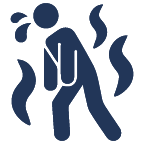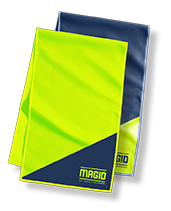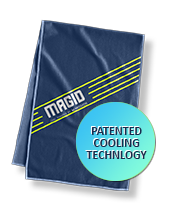By: John Heniff, Content Copywriter, Magid
High temperatures on the job can make people miserable. And whether it’s from hot weather outdoors or high-heat applications indoors, discomfort can quickly escalate from an annoyance to a life-threatening situation. In fact, every day in the United States, 11 workers are seriously injured or die from heat stress, resulting in incidents that cost an average of $53,000. Here are a few tips to make your workers aware of the causes of heat-related illnesses and some solutions to help everyone keep their cool.

Know the Causes of Heat Illness
Overheating can be caused by several factors – alone or in combination.

Hot and Humid Environments
The most obvious cause of overheating is working in a hot environment. That might mean construction workers in the summer months, welders in the forge any time of year, or even workers whose job brings them close to hot machinery. Always be aware of the heat factor when you consider the day’s working conditions.

Heavy Exertional Activities
Over the course of a work shift, repetitive motions, carrying heavy equipment, and rough industrial tasks increase core body temperature, deplete energy, and increase the need for fluids.

Medication and Alcohol
Certain medications and even recent alcohol consumption can make workers more susceptible to heat illness. Common medicines for blood pressure, depression, and even colds and allergies can make them less able to regulate their body temperature and hydration levels.
While you might not specifically ask people if they’re taking medication or if they had a drink with last night’s dinner, you can give them a general heads-up to be aware of their own risk factors.

Dehydration
For many of the reasons we’ve mentioned here, workers often arrive for the day already dehydrated. Hot working conditions only contribute to this problem and rob workers of the fluids they need. It’s important to note that, while this is a key factor in keeping workers safe, hydration alone does NOT prevent heat illness.

Underlying Health Conditions
If your workers have previously experienced a heat illness or live with a chronic health condition like diabetes, obesity, or high blood pressure, these kinds of conditions can negatively impact the way their body cools itself down. Even if you can’t ask them directly about their medical history, it’s a good idea to issue a general reminder before your team starts working in the heat.

Provide Quality Body-Cooling PPE
Remind workers whose jobs require sleeves, jackets, coveralls, or any other PPE that tends to trap heat against the body to keep a particular eye on their hydration and any signs of heat illness. You can also provide your workers lighter-weight PPE solutions that will offer them protection while reducing the potential for heat stress. Consider using the cooling PPE mentioned in the Provide Quality Body-Cooling PPE section below.
How to Prevent Heat IllnessEducate Your Workers
Make sure your workers understand the ins-and-outs of heat illness by using posters or safety trainings that include risk factors, the differences between various types of heat illness, which symptoms are more serious than others, the importance of hydration and body cooling, and what to do in an emergency.
- Training Classes: The summer months are an ideal time to remind workers of the difference between heat exhaustion and heat stroke, the importance of hydration, and what to do in an emergency.
- Reminder Posters: Post reminders to help workers keep heat safety in mind and as a handy reference listing the symptoms of heat illness and what to do in case of emergency.
Gauge the Day’s Weather
Your favorite meteorologist can’t always predict the heat and humidity on your jobsite. The best way to determine the temperature your people are working in is to use a wet bulb globe temperature monitor to gauge the site’s microclimates – the real temperature based on heat, humidity, airflow, and other factors.
Switch Up the Work-to-Rest Ratio
Once you know the correct temperature, you can adjust the amount of breaks your workers take and how long they should rest and rehydrate. Hotter temperatures require more frequent breaks and better hydration!
Acclimate Workers to the Heat
According to OSHA, almost half of heat-related deaths occur on a worker’s first day on the job, and over 70 percent occur within the first week. Prepare your workers for warmer temperatures through acclimatization — the process of letting the body adapt to heat stress. Workers who are well acclimated to hot environments develop physiological defenses such as a lower heart rate and an increased sweat rate while working in the heat.
Emphasize Proper Hydration
Remind your workers that one sip of water isn’t going to cut it! Encourage them to drink water the night before, during their shift, and after work to stay hydrated throughout the day. Most importantly, make sure the water they drink during breaks is kept cold and that it’s near enough to their work area to give them constant access.
Provide Quality Body-Cooling PPE
Keep your workers cooler on the job with products developed specifically to beat the heat. Magid® Cool Powered by Mission® emphasizes body cooling that’s instant, portable, and lasts for hours through a combination of water and air cooling. Other product designs like the T-Rex® Windstorm Series® provide mesh constructions and different types of venting to allow better airflow and moisture-wicking materials to encourage moisture evaporation. Above all, be sure you’re supplying the coolest, most comfortable protection possible while keeping your workers safe.
This article was originally published on the Magid Glove & Safety Manufacturing Company LLC website.




